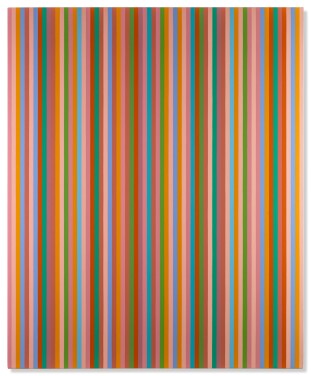Works by Bridget Riley at Sotheby's
Bridget Riley Biography
An icon of British art of the 1960s, Bridget Riley is best known for her dynamic black and white geometric paintings. Exploiting optical phenomena to evoke compelling sensations of movement, color and three-dimensionality, Riley’s canvases interrogate not only how we see, but the phenomenological experience of seeing. Much to Riley’s chagrin, her designs—appropriated for use on clothing, posters, textiles and other mass-market paraphernelia—became synonymous with the Op Art fever of the psychedelic ‘60s. While hyper-saturation of Op Art imagery ultimately led to the style’s decline in popularity, Riley and her work have maintained their relevance. Today, her investigations into the physical, psychological and social aspects of visual sensation and perception continue unabated.
Riley was born in 1931 in Norwood, London. She studied at Goldsmiths’ College and then the Royal College of Art, graduating in 1955. While her early paintings were executed in an Impressionistic style, she soon evolved toward an interest in the Pointillism of Georges Seurat and his theories of light and color. As her practice matured, Riley began to experiment more boldly with optical phenomena, and by the early ‘60s, she was creating clean-lined geometric patterned paintings in the style for which she is now known. Her first solo show, held in 1962 at London’s Gallery One, was met with great acclaim; the following year, she was included in the New Generation exhibition at Whitechapel Gallery. In 1965, Riley made her US debut with a sold-out show at Richard Feigen Gallery. That same year, she participated in the legendary group show The Responsive Eye, at the Museum of Modern Art in New York. In 1967, Riley began to introduce color into her paintings; a 1981 trip to Egypt led to a fascination with the dynamic use of color in ancient Egyptian art that continues to this day.
Riley has been recognized with numerous awards and distinctions throughout her career. In 1968, she represented Great Britain at the Venice Biennale, where she became the first woman to win the International Prize for Painting. She was awarded Commander of the Order of the British Empire in 1974 and Companion of Honour in 1999, and holds honorary doctorates from the University of Ulster, Oxford University, Cambridge University, De Montfort University and the University of Exeter. Her paintings are collected by institutions worldwide, including the Museum of Modern Art in New York; National Gallery of Art in Washington, D.C.; Tate Gallery in London; and Peggy Guggenheim Collection in Venice. Riley currently lives and works in London.












